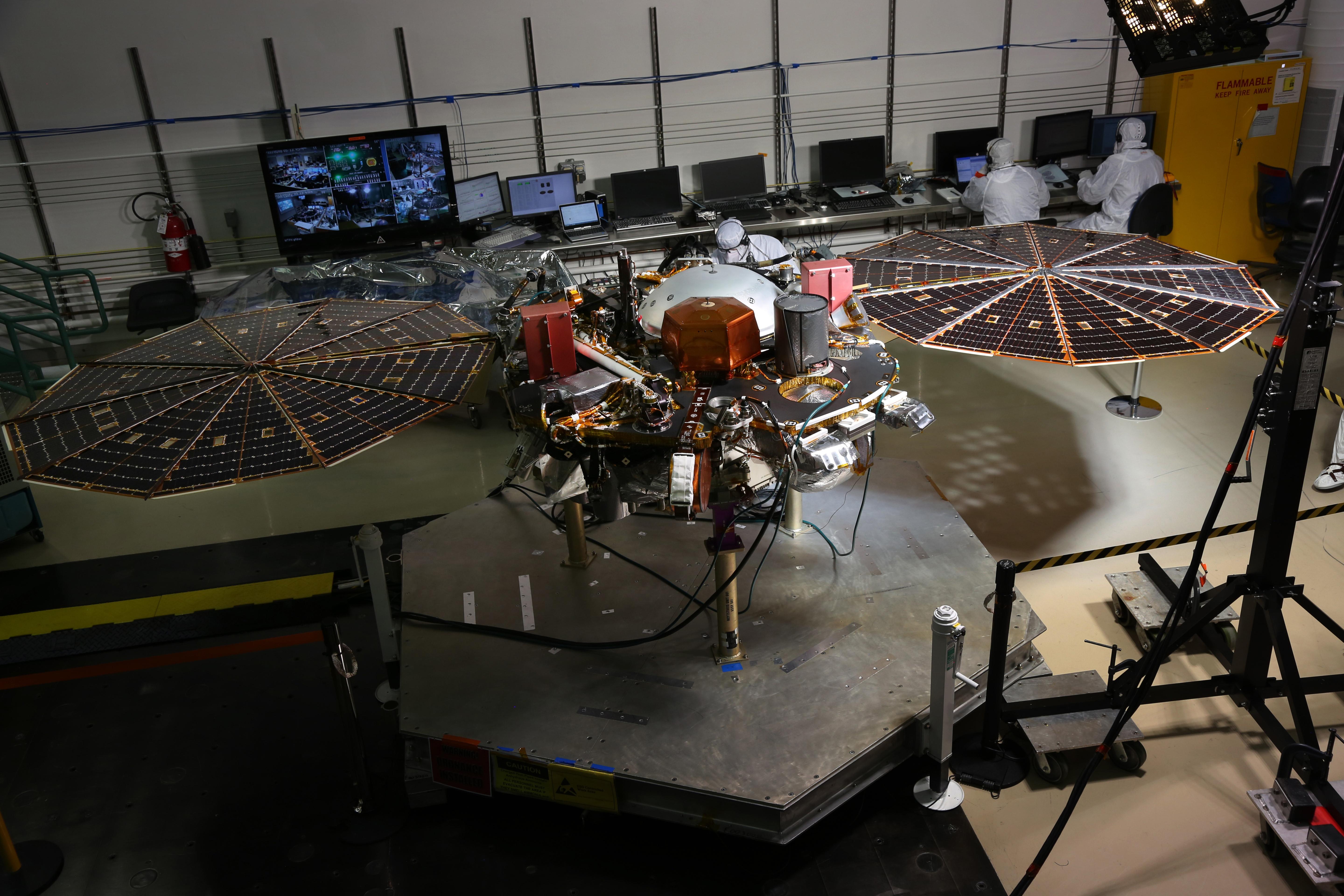What lurks beneath Mars’s surface? How did the rocky, Red Planet form? What can Mars teach us about our own planet Earth? Soon, these questions will start getting answered by NASA’s newest Mars lander, the Interior Exploration using Seismic Investigations, Geodesy, and Heat Transport, or InSight. With its seismometer and heat probe instruments, InSight will investigate the deep dynamics of Mars, helping scientists discover what lies within its core and learn more about how rocky bodies form throughout the solar system.

Jim Green:Our solar system is a wondrous place with a single star, our sun, and everything that orbits around it – planets, moons, asteroids and comets – what do we know about this beautiful solar system we call home? It’s part of an even larger cosmos with billions of other solar systems.
Hi, I’m Jim Green, Director of Planetary Science at NASA, and this is Gravity Assist.
I’m here at JPL, the fabulous place in Pasadena, California that make a lot of dreams happen, and they do some remarkable missions. And one of the missions, going to Mars that we want to talk about, is the INSIGHT Mission. And I’m here with Bruce Banerdt, the principal investigator for NASA’s InSIght Mission. Welcome, Bruce.
You know, one of the neat little things that you have, and that is a name Bruce Banerdt, and isn’t that The Hulk?
Bruce Banerdt:It is, it is The Hulk. And I just have to tell you, don’t make me mad. I mean, you can ask me about it, but just be careful here.
Jim Green:All right, I understand that completely, and I don’t plan on doing that. What does InSight stand for? It’s an acronym just like everything else NASA does, seems to be.
Bruce Banerdt:So, InSight stands for Interior Exploration using Seismic Investigations, Geodesy and Heat Transport. And if you put the capitals and the lower cases together right, you get InSight.
Jim Green:All right, that sounds cool. Well, a couple parts to that we want to really tease out—seismic investigation. You know, what is that all about? What does that mean?
Bruce Banerdt:Well, seismic investigation is really the heart of this mission. Seismology is the method that we’ve used to gain almost everything we know, all the basic information about the interior of the Earth, and we also used it back during the Apollo era to understand and to measure sort of the properties of the inside of the moon. And so, we want to apply the same techniques but use the waves that are generated by Mars quakes, by meteorite impacts to probe deep into the interior of Mars all the way down to its core.
Jim Green:You know, that’s a fascinating concept. You would have thought that we’ve had seismometers on Mars before. You know, why has it taken us so long?
Bruce Banerdt:Well, we did send seismometers once before back during Viking, but it was kind of an afterthought on that mission, which was mostly focused on looking for life on Mars. And so, it was like–it was attached to the top of the deck, and they didn’t have the resources to have some method of putting it onto the surface. And, you know, it was just sort of a shot at the buzzer, seeing if they can get something. But, since the seismometer’s on the deck and it’s trying to measure very subtle vibrations on the ground, it wasn’t very sensitive, and it–over the course of the mission, mostly what it measured was just the wind blowing the spacecraft around. So, we really haven’t had what I would consider a top notch seismic investigation of the planet.
Jim Green:Okay, I understand that part of it. In fact, what it did tell us is what not to do, right–?
Bruce Banerdt:–Right, yeah–.
Jim Green:–And what we had to do. And so, that means the seismic system that’s gonna be on InSight is really well prepared in that you’re gonna have to move it to the ground, and you’re gonna have to protect it from the wind. And so, how are you gonna do that?
Bruce Banerdt:Well, we’ve put a lot of thought into it, as you can imagine. I mean, on the Earth, you put a seismometer kind of in the basement of a building in a vault, and you keep the temperature really constant, and you don’t have any air moving through and so forth. On Mars, we’re putting it out on the surface in a really harsh environment.
And so, what we’ve done is we put a robotic arm on the spacecraft, first of all, that’ll pick it up off the deck, move it out in front of the spacecraft about two meters away from the spacecraft and put it down in a place that we find that has no rocks, no holes, so it’s nice and stable.
Once it’s out there, it already has built into it two different layers of protection. It’s inside a spheroidal enclosure that has a very hard vacuum, so it’s like being inside a thermos bottle. And then we have around that some thermal blanketing that protects it some more from the temperature. But, once it’s on the surface, we go back with our robotic arm and pick up what we call our wind and thermal shield, which is like a big upside wok with a curtain next to–on the sides. We put it over the seismometer. It’s actually got some chainmail around the bottom that’ll drape over rocks and kind of seal the bottom against the wind blowing in underneath. And so, at that point, the seismometer is pretty well protected from the elements, although it’s still gonna experience that huge temperature variation that Mars sees from day to night.
Jim Green:You know, these instruments, these seismic instruments that you’re gonna put on Mars, I think they’re the most sensitive seismic instruments ever made.
Bruce Banerdt:Well, that’s not quite true. I mean, there’s some on the Earth that a little bit more sensitive, especially at long periods, you know, when waves are–have periods that are, you know, hundreds of seconds long, you know, long rolling waves. That’s really difficult to do, and it takes some fairly, you know, heavy electronics and heavier mechanical systems. But, in terms of the sensitivity of a small seismometer, a portable seismometer, these really are, you know–well, I was gonna say world class, but obviously, they’re solar system class.
Jim Green:How many quakes do you expect to get?
Bruce Banerdt:Well, we’ve done a lot of analysis on that, and the short answer is we don’t really know. But, of course, being scientists, we’ve got to try to figure it out. And so, we’ve looked at Mars. Mars is crisscrossed by faults. And we can kind of date, you know–find out how old a lot of those faults are. We can measure about how much displacement has been on those faults and figure out how many quakes that took.
And so, we can chart out sort of the amount of seismic activity over the life of the planet. And some of these faults go back billions of years, and we extrapolate that rate to the present. And of course, it’s dying off with time as Mars cools down. And when we extrapolate it to the present, you come up with a level of activity, you know, a frequency of occurrence that gives us an idea that we’ll probably see somewhere around 50 quakes during the course of our mission. Of course, that could be off by quite a bit, but we have a reasonable confidence that we should see something, you know, between maybe 20 and 100 quakes over the two year life of this mission.
Jim Green:You know, we’re sitting out here in California, and it sometimes quakes. And so, what are the kind of things that you can do that would compare the data that we get here on Earth with those on Mars?
Bruce Banerdt:Well, I mean, when you feel a quake, I mean, that’s a lot of motion, right? I mean, sometimes, it’s enough to shake your house down. What we’re actually looking for on Mars are not the ones that are gonna knock the spacecraft over. We’re looking at quakes that happen on the other side of the planet because what we really want to see are waves that radiate out from these quakes and pass through the deep interior of the planet and then come back up and are then sensed by our seismometers.
So, it’s like, you know, in California, we have seismometers that routinely pick up quakes that happen in Japan, that happen in India and the Middle East, and we use those quakes, use the waves from those quakes to probe the deep interior. So, you’ve got waves, they start at the quake, and then they pass through the rocks of the Earth, and as they pass through those rocks, they change their character depending on the properties of the rocks.
You can think of it as kind of picking up information as the waves travel through, and then once we sense them with our seismometer and you make those wiggly plots that you’ve seen of seismograms, we have techniques to take those wiggles and analyze them, the shape of the wiggles, their frequency, their amplitude, their timing and sort of pull out that information and start putting together a picture of the inside.
I mean, we think of sometimes as quakes as being like little flashbulbs that go off, and they illuminate the interior, and our seismometer is the camera that picks up the reflected energy, and over time, we can use that to put together kind of a 3D picture of the inside of the planet.
Jim Green:Well, you know, as you say, we are scientists, and so we always have our own models. So, we must have some sort of model of the structure of Mars that the seismic information will really straighten us out. What’s Mars’ structure like?
Bruce Banerdt:Well, all the terrestrial planets, all the rocky planets have a similar structure, and we know that from gravity measurements, from measurements of their dynamics and so forth. And we know that the planets have a very dense metallic core, mostly iron and nickel, surrounded by a mantel of very dense silicate rocks with a high density because of the pressure that they’re under, and then it’s surrounded by a crust of the kinds of rocks that, you know, you can pick up in your back yard. And those rocks have a lower density, and they in fact probably floated to the surface early in the planet’s history.
And so, we have a more or less three layer system—you know, core, mantle and crust—of differing properties. What’s really critical is understanding the details of that structure—you know, what’s the size of the core, is it pure iron, does it have other elements in it like sulfur or carbon, what’s the structure of the mantle? Does it have mostly iron silicates, or is there more magnesium in there. That turns out to be a critical parameter.
And then the crust—you know, how thick is the crust, what is—what’s the mineralogical composition of the crust, and how much of the radioactive material in the original chondritic dust that made up the planets, how much of that has been moved into the crust through the process of differentiation? That process tends to concentrate the radioactive materials, and that has a big effect on the heat flow, on the thermal state of the interior, and on, you know, things like volcanism and tectanism.

Jim Green:Well, here on Earth, we believe we have aspects of a liquid core. Is that true on Mars, and can SEIS tell us if that core is solid or liquid?
Bruce Banerdt:Well, we have data from orbital measurements that indicates that the core, at least the outer part of the core is probably liquid. I mean, we can see by the variation of the planet’s rotation under the influence of the sun’s tides that it’s probably liquid. InSight will be able to tell for certain whether it’s liquid or solid by looking at the waves that travel through the core. Liquids can support P waves, the compressional waves in earthquake waves, but it can’t support S waves, shear waves, because those require a bending stresses, which you can’t have in a liquid. So, we’ll be able to tell for sure whether the outer core is liquid.
Whether there’s a solid inner core like the Earth, that’s a tough thing to figure out. If we stay there long enough and we get enough really good data, we might start to be able to see all the way deep into the center of the core to see whether that’s–it’s solidified in the center or not.
Jim Green:You know, one of the things that you mentioned that really struck me is, you know, the planet is cooling, you know? All our planets are still in the process of cooling off. It’s like, you know, they were baked in an oven, you pull them out, and the cake is still cooling off.
Bruce Banerdt:Yeah.
Jim Green:So, that means we need to measure its heat flow, and you have another fantastic instrument on InSight that does that.
Bruce Banerdt:That’s right. And the heat flow from a planet is really a measure of, you know, the energy that’s driving the geology of the planet. So, if you see mountains, if you see giant valleys that are formed by riffs or volcanoes, those are all being driven by the heat flow of the planet as well as fault activity. The plate tectonics on the Earth is driven by the Earth’s heat engine. So, the heat is coming up from the deep interior, driving these motions and then being radiated out to space.
So, we know that Mars does not have plate tectonics. We can see that because there’s no evidence of that kind of faulting on the surface. But, we also know that it is radiating heat. It’s got a history of volcanism. And it does have many faults on the surface even though they’re not organized as plate boundaries. And that–those–that faulting is, we think, mostly driven by the contraction of the planet. As the heat flows out of the planet, it contracts just like anything as it cools off contracts, and as it contracts, it crumples a little bit. And that crumpling is manifested in quakes and seismic activity.
Jim Green:So, this instrument is called HP3?
Bruce Banerdt:Yeah, it’s called HP3, which stands for the Heat Flow and Physical Properties Package. And it’s really kind of an interesting and cool instrument because it has a little torpedo about a foot and a half long and about an inch in diameter, and it has inside a hammer, so kind of a hammer. It has a motor that winds up a mass on sort of a helical track and pulls it up against a very stiff spring, and it gets to the top and lets go and goes pow down against the nose of it. And it knocks itself down into the soil just a few millimeters at a time, bang, bang, bang, and it does that about 10,000 times and can burrow down up to five meters deep into–below the Martian surface.
Jim Green:Now, of course, that’s on the deck originally, and you’ve got to use the arm and pick it up and situate it.
Bruce Banerdt:That’s right. That’s our third deployment activity with the robotic arm. Yeah, the arm has like three main jobs. It has to get the seismometer on there, has to put the cover on the seismometer, and then it goes back and gets the heat flow probe. And because we’re–we have to do things really carefully and get it right the first time, it’s gonna take us a couple months to go through that whole process.
Jim Green:Well, what’s really neat, as you say, this hammer, as it operates, is the seismic instrument on during that time period?
Bruce Banerdt:It is gonna be on during that time period. And this isn’t, you know, one of the–this isn’t the main goal of the mission, but it’s really cool because those seismic waves from the hammer knocking it into the soil, they’re gonna go bouncing around underneath the surface, and we will probably be able to like see what kind of layering there is in the top, you know, 20, 30, maybe even 50 feet of the Martian surface.
We think there’s actually more or less hard lava flows beneath this layer of kind of broken up soil and gravel on Mars, and we should be able to get reflections off that and see whether it’s even more solid at depth. And that should be really interesting for people.
And it’s actually kind of interesting when we think about astronauts going to Mars in the future because, you know, building things on sand is not the smartest way to go about, you know, putting up buildings and stuff. So, we’d like to understand kind of what the strength is of the Martian regolith so that when we do send people there, we’ll know what kind of geotechnical techniques to use to make structures.
Jim Green:Yeah, absolutely. The kind of measurements that you make just in those two areas could be very important for human exploration of Mars in the future. But, you’re not done. You’ve got other instruments on InSight.
Bruce Banerdt:Oh, that’s right. I mean, well, first of all, you know, once we burrow down, you know, what that Heat Flow Package does is the actual instrument isn’t in the torpedo. The actual instrument is in the cable that connects it back up to the surface. And every couple feet along that cable, we have a little temperature sensor. And those temperature sensors measure not only what the temperature is underneath the surface, but it’s measuring how much the temperature is increasing as you go down. And it’s only increasing by hundredths of a degree, but we measure it very precisely, and we can extrapolate that increase in temperature down deep into the planet. And that’s how we actually understand how much heat is coming out of the planet.
Jim Green:So, then in addition to HP3 and the seismic instrument, SEIS, you have wind measurements that you make, cameras.

Bruce Banerdt:Yeah. We’ve got a whole meteorological package that measures the wind, the speed and the direction of the wind. It also measures pressure variations. So, it’s, you know, sort of a barometric experiment, as well, plus the temperature of the atmosphere. So, we have sort of a complete weather package on there that will be running, you know, 24.6 hours a day and all through the year–.
Jim Green:–Which is the length of the Mars day–
Bruce Banerdt:That’s right. We’re planning to put up a page on the internet that’s sort of, you know, weather on Mars, you know, sort of like Weather.com except for Mars, and you’ll be able to see, you know, what the weather was like on Mars yesterday. I don’t think we’re gonna be predicting very much, but, you know, at least being able to tell what the weather’s like, that’s gonna be something cool.
Jim Green:Well, one of the things you told me just a little while ago that I was really excited about is the app on your phone that you can–that you guys are thinking of pulling together.
Bruce Banerdt:Yeah, we’re trying to put together a marsquake app. You know, the USGS has an app that’ll, you know, it’ll buzz you when there’s an earthquake that’s happened somewhere on the planet. You can go and check it out. We’re gonna do the same thing for Mars. We’re gonna have a Mars Quake app. So, you know, it’s running on your phone, and it starts buzzing in your pocket, and you pick it up and it says, oh, there was a marsquake out in Tharsis Plateau yesterday, and check it out, you know? So, we hope to be able to get that. It’s not gonna be in real time because it takes a couple of days to get the data down, but as soon as we get it on the servers, it’s gonna go out to the public, and that should be a lot of fun.
Jim Green:Well, you know, you mentioned also that the quakes could be from impacts.
Bruce Banerdt:Yeah. So, when a meteorite hits Mars, it’s gonna make a pretty big seismic signature. We can have pretty small impacts because the Martian atmosphere is so thin, even, you know, things, you know, the size of a golf ball are gonna come in and make a crater. And if it’s close enough to InSight, we’ll be able to pick those up.
And the cool thing about that is, once we’ve gotten an impact event on our seismometer, we can go back and talk to the MRO orbiting spacecraft and the high resolution, HiRISE camera and say, hey, go check out this area here, we’ve got an impact that happened, you know, somewhere within, you know, maybe 10 kilometers of this place, go see if you can see anything new there. And, you know, they’ve already kind of blanketed the area around InSight with before pictures, and they’ll go and do the after pictures and see whether they can see a new crater. And if they can do that, that actually helps a lot, too, because then we know exactly where it was, and then we can use all the information from the seismogram to look at the interior and not kind of waste some of it on figuring out where the Mars quake was.
Jim Green:Yeah, no, that sounds spectacular. That’s got so many dimensions about it that are really fundamental planetary science. And the ability to get this data and then compare it with Earth I think is really revolutionary and tells us a lot about how these planets are built.
The fact that Mars is smaller than Earth, might have been put together a little differently, you know, the core might be a different ratio in terms of its size than the Earth’s core.
Bruce Banerdt:Uh-huh.
Jim Green:You know, and so settling some of these questions can really help us on how our solar system was formed.
Well, it’s coming up, the launch. Where are you launching from?
Bruce Banerdt:We’re launching from Vandenberg, California, which is a first for planetary launches. All the other launches to the planets have gone off from Florida. We’re in kind of a unique situation in that we have a relatively small spacecraft that was designed for a relatively small rocket, and those small rockets aren’t available any more. They’ve kind of gone out of production. And so, we are on an Atlas 5 rocket, which has about twice as much capability to go into space as the Delta 2 that our spacecraft that, when it was Phoenix, was originally designed for.
So, instead of having to go to Florida and using the Earth’s rotation to help slingshot us into orbit, we don’t have to use that. We can blast our way straight out, you know, into a polar orbit. By moving to California, that kind of took some of the pressure off of the traffic jam they tend to have over in Kennedy Space Center, lots of rockets trying to go off there. We were able to relieve them of some of the pressure, plus we get to launch in a way that is gonna be visible to maybe 10 million people in Southern California because this rocket’s gonna go right by LA, right by San Diego. And if people are willing to get up at four o’clock in the morning, they should see a pretty cool light show that day.
Jim Green:Yeah, May the 5th, coming up.
Bruce Banerdt:That’s Cinco de Mayo.
Jim Green:That’s right. So, May the 5th it launches.
Bruce Banerdt:That’s right.
Jim Green:Goes straight south.
Bruce Banerdt:Uh-huh.
Jim Green:Goes under the South Pole and then takes this mean left turn on its way to Mars.
Bruce Banerdt:That’s right.
Jim Green:So, when does it get there?
Bruce Banerdt:It gets there on November 26, which is Cyber Monday right after Thanksgiving. And that’s true whether we launch right at the beginning of our launch period or later on if there’s a weather delay or some kind of an issue with the rocket. Whenever we launch over the five weeks that we have available to us, it’s gonna get to Mars on that same day.

Jim Green:Oh, that’s fantastic. Well, I’m gonna be celebrating both the launch and the landing.
Bruce Banerdt:You better believe I will, too.
Jim Green:You know, one of the things that I ask all the guests that come on this podcast is really about their gravity assist. You know, gravity assist is a planetary term, but in reality, people, places and things that affect our ability to think about what we’re gonna do and how we’re gonna do it, what we’re gonna do when we grow up. That’s a gravity assist. So, what was your gravity assist that got you on a direction to become the scientist you are today, Bruce?
Bruce Banerdt:My gravity assist was the Mercury Program. When I was five years old, Scott Carpenter was blasted into space on top of what looks today like a tiny little rocket. And my mother insists that I only learned to read so that I could read the newspaper articles about the Mercury program, and I was just completely fascinated and completely entranced by the idea of people going into space. And so, I was just–I just followed the space program, and I wanted to be a space scientist some day. Well, I wanted to be an astronaut, which we all thought was exactly the same thing as a space scientist. It’s not quite, but close enough.
Jim Green:Rocket scientist–yeah, we called rocket scientists–.
Bruce Banerdt:–And of course, by the time I got to high school, I kind of gave up on that as a dream that could never come true, and I went to college, and I studied physics. And then I decided to kind of go into geophysics.
And then when I went to graduate school at Penn State, by some wild coincidence, one of the other grad students was a Caltech grad who had worked at JPL for a couple years before getting his Ph.D. And we got to be friends, and he said, oh, you know, the Viking mission is going to Mars next summer, and I know a couple of scientists there that are looking for summer interns, you ought to apply. And I thought, I could apply to that, I could actually go and actually work on something in space?
So, I applied, and I got selected, and I went to JPL for the summer. And then I went back to Penn State at the end of the summer. And again, one of those wild coincidences, my graduate advisor got a job at a university back in California and invited me to come back with him, and I went to JPL and I said can I work here part time while I’m working on Ph.D., and they said sure. And I grabbed onto JPL, and I never let go. This is the only job I’ve ever had in my life other than working in the tire shop during the summertime.
So, that’s my gravity assist. It’s like, you know, I’ve always wanted to work in space. I sort of lost the faith for a while and wandered in the wilderness. But, by luck and being at the right place at the right time, you know, here I am today.
Jim Green:Yeah, sometimes, it takes several gravity assists to get us–.
Bruce Banerdt:–That’s right–.
Jim Green:–In the right direction. Yeah, indeed. Well, it’s really been a delight, Bruce. I thank you so much for coming on and telling us all about InSIght.
Bruce Banerdt:Well, I don’t like talking about anything more than InSight except maybe my kids, so this has been fun.
Jim Green:Thank you. Well, until next time, this is Jim Green, and this has been your Gravity Assist.




























